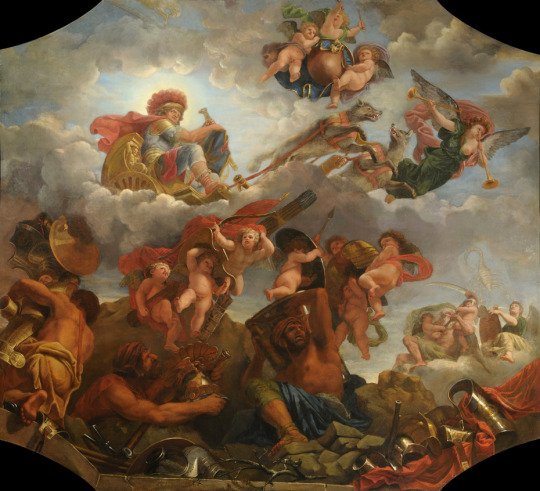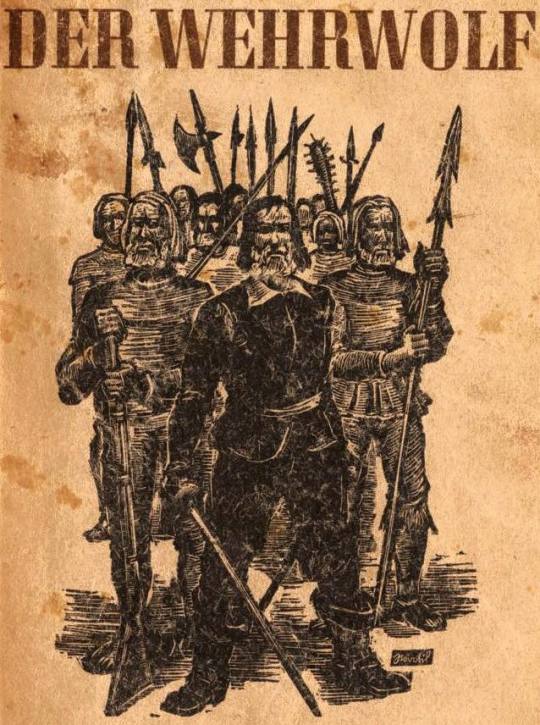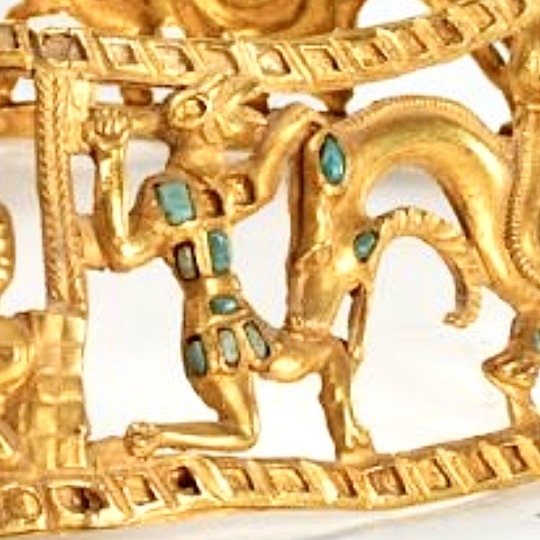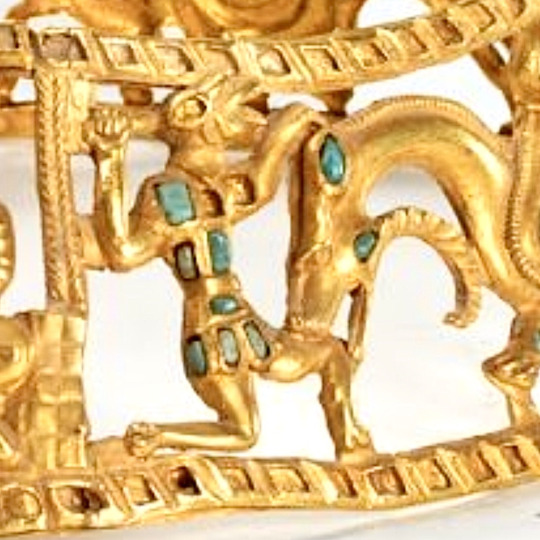#mannerbund
Text
Youth-Warriors of the Indo-European Wolf-Cult
The kóryos is a hypothetical iniatory military fraternity theorised to have existed in Proto-Indo-European society based on traditions found in sundry Indo-European socities, such as the Irish fianna.

This is a largely fictional depiction of a warrior-youth partaking in a kóryos initiation-ritual. Since the kóryos is largely a reconstructed rite, without any written accounts, and scant archaeological evidence, this sketch is a composite based on the imagery of the Kernosovskiy Idol, the Torslunda Plate Beserkr, and the Warrior of Hirshladen.

Another illustration inspired by the kóryos tradition, this time focusing on the possible connection between the cult-fraternities and the origin of the werewolf in pan-European mythology. The kóryos iniation rite is believed to have involved a ritual wherein the youths "died" and were reborn as wolves filled with a warrior frenzy (see: Cú Chulainn, Berserkr). During their summer rangings, these frenzied youths would raid other settlements and engage in theft, murder and rape; all sins commited while "in wolf-shape" were believed to be cast off when a second ritual to excise the warrior frenzy was performed.For example, after the young Cú Chulainn slew the three sons of Necht and was overcome with battle-fury, the household of Conchubar mac Nessa had to literally boil away the boy's rage. One taboo which werewolves are frequently shown transgressing is cannibalism, and the above illustration shows a kóryos member with man-blood still fresh on his lips.
#barbarian#berserker#berserkr#cannibal#celtic#werewolf#indoeuropean#wolfcult#koryos#mannerbund#kóryos#männerbund#boytroop#sonoftheland#torslunda#kernosovskiy#hirshladen
4 notes
·
View notes
Text
A male figure asked me in a dream last night if I'm ready to lead yet, and I didn't have an answer yet
I know what I have to do, I just need to pick up the pace and not fall off the path. Destiny won't wait for me, I have to rise to meet it
2 notes
·
View notes
Note
Right wing fruit cakes need to show me their butthole whilst they recite lines from Yukoku and Runaway Horses. I need a right wing fruitcake to firmly plant his leather clad crotch on my face…. Mishima’s homosexual writing and sexual novels are more right wing than sun and steel, the sensuality, the passion, his depictions of sex, homo or hetero etc, harkens back to antiquity, to Scythian mannerbunds and aristocratic courting…. God I’m so fucking horny
Calm down fruitcake go take a cold shower or something.
12 notes
·
View notes
Text
The wolf of Mars
After asking about Mars and wolves and getting inspired to look around I'm just going to go all on in here on the subject just like on Twitter because by gods the more I think about the subject the more I love it.
Mars apparently was frequently accompanied by wolves, and not just because his offspring were raised by a wolf. Livy apparently described a statue of Mars on the Appian Way in which Mars was accompanied by wolves. Livy also, in The History of Rome, recounted a story where a wolf appeared as a reminder of Mars as the founder of the Roman people and an omen of their good fortune. In Rome there was also a "lupus martius", or "wolf of Mars", that was believed by Romans to be an omen of victory in battle. There is also Roman iconography featuring Mars mounted upon a wolf, or being carried on a chariot driven by wolves. See example from the 2nd century below:

This motif appears to have carried on in later depictions of Mars from well after the Christianisation of Rome and much the European continent. An example here would be "Mars on his chariot pulled by wolves", painted by Claude Audran the Younger in 1673.

Wolves were most definitely the sacred animal of Mars, a connection that is perhaps not entirely separate from the founding myth of Rome, where the sons of Mars are raised by a she-wolf.
I also cannot help but interpret resonances with a broader chthonic context relevant to the larger culture of ancient Italy. Mars, on his own, has his own chthonic context, in that he was regarded not just as a god of war but also of fertility and agriculture, patron of the virtus of the earth. He can also be seen as a descendant of similar Etruscan deities, such as Maris, who were chthonic and vegetative in nature. This link is discussed further in The Issue of Descent of the Deity Mars by Ekaterine Kobakhidze.
More importantly, in Etruscan culture, wolves were inherently chthonic symbols. They were believed to be liminal beings that could pass between presence in this world and in the underworld. Wolves were often seen by the ancient Etruscans as either demons or the spirits of the dead, or perhaps even as representing death itself. Etruscan gods of the underworld, such as Calu, Suri, and Aita, were also strongly identified with wolves. Aita himself, a god very similar to the Greek god Hades, is distinguished by his wearing of a wolf skin cap.

There may also be certain reflections of this association in ancient Greece. The goddess Athena, for instance is sometimes depicted wearing a wolf cap, such as in statues of Athena Albani. This wolfskin cap itself is traditionally worn by none other than Hades, and the Illiad refers to Athena wearing this "cap of Hades" to avoid being seen by Ares. Wolves were also strongly associated with Apollo, and the heads of wolves also featured in necromantic rituals aimed at invocation. To quote Greek and Roman Necromancy by Daniel Ogden:
Greek language lychomancy recipes borrow necromantic procedures. In one, the lamp is set on the (disembodied?) head of a wolf. Chthonic demons are summoned, and Hades is invoked. There are libations of wine, honey, milk, and rainwater, and offerings of flat and round cakes.
Not forgetting about Lupercalia, that Roman festival which revolved around the veneration of a wolf deity, Lupercus, possibly linked to Pan, Faunus, or Apollo, and celebrating the ritual purity of the community by way of the passage of ancestral spirits through the underworld.
The warrior association also invites consideration of the wolves with the bands of warriors academically referred to as "Koryos" or "Mannerbund". In Greece, for instance, adolescent war bands honoured Apollo as the master of the wolves that symbolised their fighting style. The Norse Ulfhednar, who saw themselves as shapeshifting into wolves, are often counted as another example of a similar war band. In Russia, on the steppes at what is now Krasnosamarskoe, there were midwinter rituals where people consumed the flesh of dogs or wolves to become dog-like or wolf-like themselves.
It's kind of difficult to imagine how it all leads together outside of pure UPG. I just happen find whatever thread runs between the wolf symbolism of Mars to be fascinating, though I can see how it mostly just connects to the founding myth of Rome.
#wolves#mars#roman polytheism#etruscan polytheism#hellenic polytheism#ancient greece#italy#chthonicism#chthonic gods#warrior gods#ancient rome#roman mythology#greek mythology#paganism#chthonic#war gods
34 notes
·
View notes
Text
Just finished reading The One Eyed God: Odin and the Indo Germanic Mannerbunde and it blew my dick and balls clean off my ass
Chock full of info about warband culture, the evolution of pre Christian practices into folklore- I highly recommend it.
1 note
·
View note
Video
youtube
12 notes
·
View notes
Photo

Greek Wrestling Club, Hull House, Chicago, ca. 1910
Lewis Hine
Greek Wrestling Club, Hull House, Chicago was taken at Chicago’s Hull House, a settlement home dedicated to social welfare and the assistance of immigrants that was founded by Jane Addams in 1889. The young men in this scene are gathered in a semicircle around two muscular figures locked in a fight. Holes in the shoes of one of the wrestlers and missing fingers on the hand of the man on the far right allude to a life of difficulty, but Hine’s image records a moment of boyish recreation.
37 notes
·
View notes
Photo

48 notes
·
View notes
Text
Sarmatian Wolf Torque


This torc found in an undisturbed Tumulus clearly shows anthropomorphic figures with Wolf Heads battling a dragon or serpent.
Discovered in a first-century AD Sarmatian Kobyakovo tumulus (see Prokhorova 1994).
This open-work gold torque, still awaiting a comprehensive analysis of its mythological and cultic significance, features the repeated scene of a battle between a dragon and two monstrous…
View On WordPress
1 note
·
View note
Text
https://weissalb.wordpress.com/2017/02/15/animism-the-wild-hunt-and-the-germanic-mannerbunde/
#animism#germanic paganism#mannerbund#germanic#spirituality#culture#society#tradition#paganism#pagan#nordic#animist
0 notes
Quote
What are you talking about? There are lots of aspirational male characters in anime.
Your typical shonen protagonist like Seiya, Goku, Naruto, and Deku trains like hell every day so that he can gain the power to protect the precious people he cares about and achieve his dreams, and manages to defeat the bad guy with the help of his nakama through the power of friendship, i.e. by coordinating with his mannerbund through masculine virtues like strength, courage, honor, and loyalty that enable a tribe to be military successful. I think these are pretty good role models for kids.
But its not just for kids. Seinen protagonists like Guts from Berserk and Goblin Slayer from Goblin Slayer are also totally, unbelievably, impossibly brave and manly. You yourself mentioned Jojo's. Edward Elric from Fullmetal Alchemist, Eren Yeagar from Attack on Titan, etc. The list goes on and on.
Now, yes, if you watch nothing but trashy harem comedies and isekai web novel adaptations, you are going to see a lot of nerdy losers attracting a whole harem of beautiful girls for no apparent reason and with zero effort on their part (although at least in the latter genre he will usually fuck them, sequentially and simultaneously). But in that case, it's your own fault for having shit taste in anime.
erwgv3g34
1 note
·
View note
Photo

The ancient Britons reputably fought naked, and in the prehistoric Indo-European tradition, raided and robbed people. The IE tradition survived in many parts of Europe of young men living like beasts in the wild and raiding towns and villages for wealth, food and women - the Mannerbund. Apparently this ancient tradition survived in rural England as recently as the early 19th century in the Downs near Stonehenge where a gang of naked young men would rob unwary travellers passing through the ancient landscape dominated by prehistoric barrows. Based Cherhill gang. #cherhillgang #cherhill (at Cherhill White Horse and Monument) https://www.instagram.com/p/CEJu8b4AoIB/?igshid=1d5mkus2rznq0
16 notes
·
View notes
Text
i mean, this logic reminds me of trads. steppe nomads didn’t ride horses because they were traditionalist or some nebulous notions of maintaining a horse-riding society or whatever. they road horses because they were a useful tool. of course the automobile killed horse-riding culture. but so what? there’s nothing inherently more trad or whatever about riding a horse than a car besides the aesthetics. fucking hate this obsession for living with the same material conditions our ancestors did out of some misguided notion of traditionalism.
like...the mannerbund was originally a band of germanic warriors, running around with swords and axes and pillaging and shit. but just because we don’t have bands of dudes running around with axes and shit doesn’t mean the essence of the mannerbund isn’t still present.
the spirit transcends material conditions. certainly material conditions will affect its expression, but it’s still there.
6 notes
·
View notes
Video
youtube
#mannerbund#organização social#podcast#filosofia#sociologia#homem#mulher#sede de poder#base social#machismo#patriarcado#nietzsche#homem moderno#sociedade
0 notes
Text
If all you do is bantz
and I don’t see you give guidance or be uplifting towards your brothers then I will not respect you. You just seem insecure to me.
0 notes
Quote
Love for hierarchy; relationships of obedience and command; courage; feelings of honor and loyalty; specific forms of active impersonality capable of producing anonymous sacrifice; frank and open relationships from man to man, from one comrade to another, from leader to follower—all these are the characteristic, living values that are predominant in the aforementioned view. These are the values found in what I have called the Mannerbund.
Julius Evola in Men Among the Ruins
12 notes
·
View notes